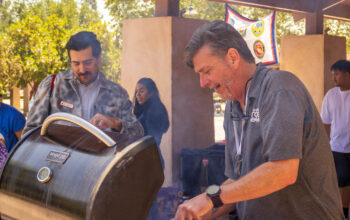Photographers often face an ethical dilemma: help someone in trouble or take the photo.
Los Angeles Times photographer Luis Sinco shared his stories during a lecture on April 20 in The Great Hall as a part of the Media Arts Speaker Series.
Sinco began his presentation by screening a video that took him about two years to complete. He documented the life of U.S. Marine James Blake Miller, who fought in the Second Battle of Fallujah.
When he returned home, he began going through depression and wanted to end his life.
“As a journalist, you’re not supposed to get involved with this guy’s life,” Sinco said.
When Sinco began sensing that Miller was suicidal, he interfered by telling him to seek professional help.
Sinco is known for the photos he has taken in Iraq and documenting the war. The last time he was in Iraq was 13 years ago.
He said even though his work sometimes exposes him to tough situations, like war, he says that there are many good things about being a photojournalist.
“It’s been a fun and rewarding job, and I appreciate the opportunity to tell stories that help promote understanding between people about issues, places, events and other folks around the world,” Sinco said. “It’s been a really good career for me. I’ve enjoyed what I’ve been doing.”
Sinco has been a photographer for Los Angeles Times for 20 years and has been taking photographs for 30.
During his lecture, Sinco said that it was difficult competing with photographers in the industry.
He said that once he got into the industry photography opened up many opportunities and led him to several places.
“I traveled the world for the L.A. Times, news, sports, features, even to Coachella,” Sinco said. “Everything is changing. If you’re into it, stick with it, start making a portfolio.”
Sinco said it is important for journalists to start adapting to every type of media to keep up.
“Journalists have kind of become targets,” Sinco said. “The print media has struggled adapting with mass media.”
Pierce College adjunct instructor of media arts David Blumenkrantz has known Sinco for about eight years and admires the attention to detail that Sinco applies to his projects, such as the documentary following Miller.
“The dedication that he has, to spend two years on a story, and just be willing to embed himself in that life of a marine, for example, and to be there with him and his wife in the most intimate moments,” Blumenkrantz said. “That takes a lot of dedication, you have to visualize what the story has to be.”
Blumenkrantz said that Sinco has a classic style in regards to his photojournalism.
“His compositions, his framing, the moments that he captures, he’s just got a great eye. A pure photojournalist,” Blumenkrantz said.
At the end of the lecture, students had the opportunity to ask questions. One Pierce student asked Sinco if he would do another documentary, to which he replied, “Definitely.”
Pierce student Nicolette Atoori is taking Journalism 251 and photography classes, and attended the speaker series.
“It was a really nice event, it was my first time knowing about [Sinco] and seeing his photographs,” Atoori said.
Pierce student Nader Soussi is also in Journalism 251 and thought it was a great lecture.
“I was familiar with him and his work,” Soussi said. “Just the effect that it has on the subjects lives is amazing.”
Sinco said he hopes to see the news media continue to do what they do because he believes it’s really important to have that freedom of the press in today’s industry.
“It’s the First Amendment. It’s not exercised by everybody as far as freedom of the press,” Sinco said. “Sure we all have freedom of religion, freedom of speech, but I think now you’re on a privileged and special position when you’re working on a newspaper, radio or television station. In the news station, because very few people get to exercise the freedom of the press, and you need to take that responsibility very seriously because you’re one of the few who’s able to do it for the rest of the people who can’t.”
Sinco said the challenge today is to find where to not only get published, but to get paid.
“It’s a lot more difficult than it used to be, because it’s not the same as it used to be. Even back 20, 30 years ago when I was getting into it, it wasn’t easy for me,” Sinco said. “You have to find any kind of avenue to get published, whether it’s online, or in print, or photographs, images, videos, or the written word, people want stuff for free. The internet is all about free, but it cost money.”
Sinco hopes to inspire future journalist adapting to an industry where everything is almost free.
“If you’re a young journalist, you’re going to be forced to do stuff for free every once in awhile, but at some point, you have to say look, ‘I’m actually putting work into this. I need to get paid,’” Sinco said. “It’s difficult now because the environment is all about free, and as I said here, there are not as many newspapers as there used to be.”
Sinco mentioned that photographers now have to adapt to social media and writers have to adapt to photography. Learning a new skill benefits them.
“Sure, it’s bad that all of the staffers and students are dropping out and forcing you to do more work, but I don’t think it’s bad for you to learn more,” Sinco said. “Capture the moment. It takes time to do something like this.”



